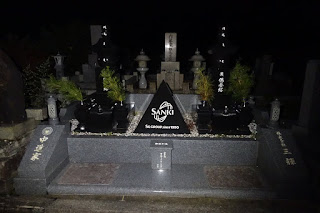The monk explained that the average tree in the cemetery is between two hundred and six hundred years old. Anyone is allowed to have a tomb there if you follow the teachings of Kobo Daishi. He stopped at a tomb to talk about how the shapes represent ground, water, fire, wind, and space. These, together with consciousness, created everything in the universe.

According to Kobo Daishi, our minds are the shape of the moon, and change according to our moods, just like how the moon changes shapes. Next, he spoke of the gates seen across Japan, such as the ones that lined the mountain I hiked the other day. These are Shinto gates. Shinto deals with being born, getting married, and other celebrations. Buddhism deals more with death. He told a story of one of the wells in the graveyard. He referred to a well in the cemetery, and if someone couldn't see their reflection, that they will die within three years. Additionally, if someone trips on one of the bridges, the same fate would be bestowed upon them.

He led us next to the tomb of Panasonic corporation. Apparently, many companies create tombs here, to pray to employees and their ancestors. He pointed down the path to an area where other companies and even animals, like dogs and termites have their own tomb. I noted this for later.

Nearly everyone stopped when one person discovered a toad along the path.

We were told of a stone nearby, whose weight was determined by the number of your sins. Then, he reminded us not to trip on the next bridge. We approached the mausoleum.



We were not allowed to take a picture of the outer part of the mausoleum. He told us how Kobo Daishi supposedly walked into his own tomb and then did not come out. About one hundred years later, a solitary monk walked in and saw Daishi sitting in a meditative position, with long hair. He trimmed his hair and then I believe he said that no one has gone in since.
While we were there, I noticed a man, in white robes, who kept bowing, leaving, coming back, and then leaving again. As we walked away, the monk referred to a nearby stone. Someone is supposed to touch the stone and then pray to Daishi's mausoleum, touch the stone again, and then repeat the process one hundred times, one each of seven days. This was in order to fulfill a wish for someone's health to get better, etc.

Next to us was a beautiful building with a ton of lanterns. It is supposed to be beautiful inside, with even more lanterns, but it was closed at night.

One last note that he gave us, while walking towards, and then away from the mausoleum, was that there was a row of Buddhist statues. Originally, monks were supposed to have to cleanse themselves in the river, but this proved difficult in the winter. Therefore, the new tradition is to bathe the Buddhist statues. By each statue were cups and water, for people to bathe them.

We were then left to our own devices. Using my phone as a flashlight, I walked back to where I took a mental note earlier. It was three trees right next to each other, which was not too easy to see in a dark graveyard. I walked down the path. At first, all I saw was one small statue. I took a picture. Later, I looked it up online, and it is supposed to be Kirin Beer's plot. The kirin is a mythological creature of east Asian origin.

Here are some other interesting tombs that I found. I will add a caption to the termite company.







 |
| Dogs tomb |
 |
| Japan Termite Control Organization |

No comments:
Post a Comment